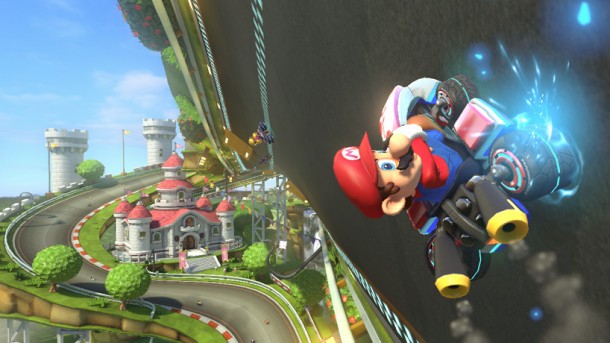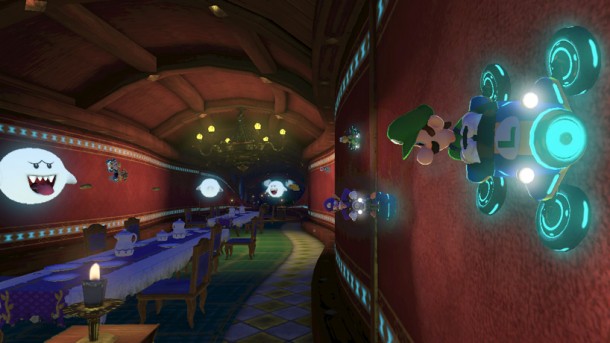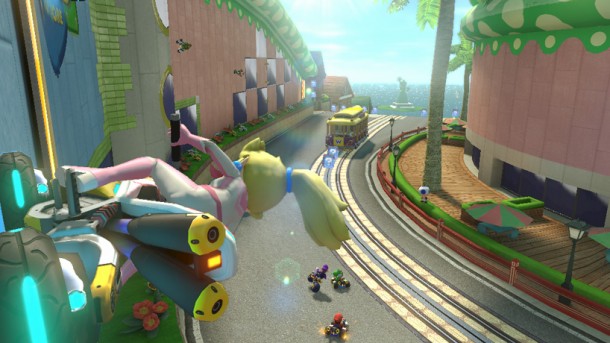
I consider myself a bit of a Mario Kart snob. I’ve owned every iteration, known the intricacies of what makes each one unique, better, or worse. In couch multiplayer, I’m unbeatable — online is a different story, but we’ll never talk about that, okay? When Nintendo announced a new Mario Kart game coming to the Wii U, I had a two-part reaction: 1) Yes, it’s yet another Mario Kart game, and 2) I’m going to play the banana peels off of it, regardless.
Mario Kart is a mainstay of gaming. Though it’s been “evolutionary, rather than revolutionary” it’s remained one of the most consistently great racing/multiplayer experiences time and again. With Mario Kart 8 I was expecting more of the same with mere sparks of innovation beyond its predecessors. And, after my hands on time with the demo at E3 last week, I can say that it is exactly what I expected, and I’m totally, completely fine with that.
Like everyone else, I want Mario Kart (and every game, for that matter) to innovate on what came before it. What that innovation is, I’m not quite sure. Anytime something drastically changes in a series it tends to “break” it. Perhaps slow evolution is a good thing: the driving needs to remain exactly the same, because Nintendo perfected the kart racing experience. The innovation needs to come from the track design, the online infrastructure, rankings, races, and so on.

With Mario Kart 8, Nintendo seems to understand that. They’ve taken the driving intricacies of the wonderful Mario Kart 7 for the 3DS and focused on the ideas that made that game so good. For one, the track design is no longer “flat.” I raced along paved roads, sure, but the amount of splitting paths in the courses, as well as the ability to drive on the sides of buildings in some sections, made each time around unique. There’s a bit of influence from the F-Zero series here, and it shows. The course design of Mario Kart 8 looks like it’s going to be the best of the series, allowing for racers to take on the tracks any way they want. The demo station I played had been set up for three turns around the track, and each time I didn’t know when one loop ended and another began. That’s a good thing. It forced me to become non-complacent when in the lead, as I never knew when an opponent would be close enough to pass me by.
Each of the courses has a variety of driving, gliding, underwater, and hover sequences, with unique hazards and changes to the way vehicles react to them. I drove Wario on a heavy roadster first, plowing down straightways and building up good speed to launch over gaps. The aerial boost tricks are back, which means that players who choose motorcycles as their vehicles can land easier and boost through corners, giving them an advantage to make up for other shortcomings. With wider tracks, that also means passing has become more important in 8, and learning how to effectively steal air boosts from behind opponents could make for interesting position changes around the courses.
The demo speed was set to 50cc, unfortunately, so I couldn’t get a real sense of how fast an HD Mario Kart game could get. However, that allowed me to focus more on the great visuals. As surprising as it may be to say it, Mario Kart 8 might be the best looking game on the Wii U. That’s not a shortcoming by any means, though. It looks fantastic, with rich environments and big, detailed characters and vehicles on the screen. It’s a pretty game, and one that may be the first real showcase of what the Wii U hardware can do.
The game seems to rely less on rubber-banding, and more on technical driving and maneuvering of courses. Though, that may just be how our demo played out. It controls exactly like the Wii’s Mario Kart edition, with the ability to choose between motion controls or analog sticks (the GamePad even allows that to take place on the fly). Keeping the technical driving the same, and focusing the studio’s energy on the courses, could make 8 the best in the series, in terms of actual racing.

As far as the Wii U’s Gamepad, this was perhaps one of the worst uses of it I’ve seen in the console. Yes, Off-TV play will be great, but when using it as a second screen it is quite literally just a big button for a horn. That’s it. That’s poor usage of the console’s schtick. Hopefully, the company does something (anything) to make it a worthwhile piece of equipment to play the game.
Mario Kart 8 was a fantastic racing trip, and perhaps the best game in Nintendo’s booth at E3. Though it won’t change the karting genre forever, the renewed emphasis on course design and the push for competitive online play and community — with Miiverse integration and the ability to capture and share video, though it wasn’t on the show floor — could make Mario Kart 8 a really fun racing experience when it launches in 2014.

![E3 2013: Off the wall with Mario Kart 8 [Hands on]](https://www.sidequesting.com/wp-content/uploads/mario-kart-8-e3-1.jpg)
No Comments